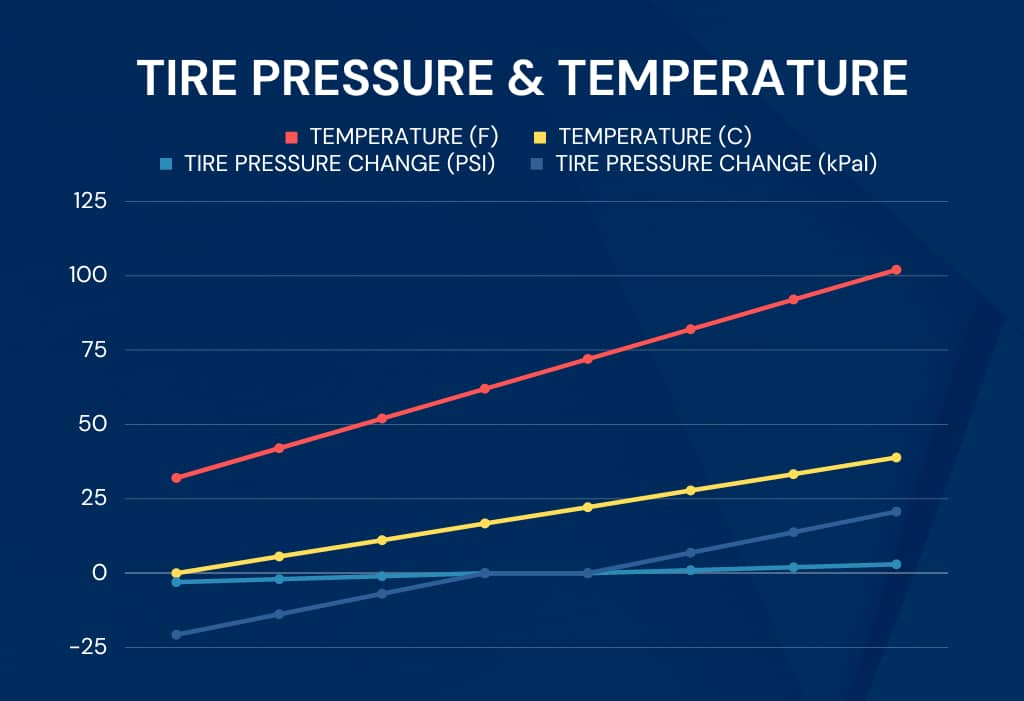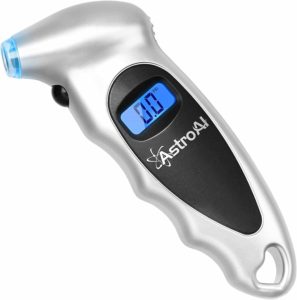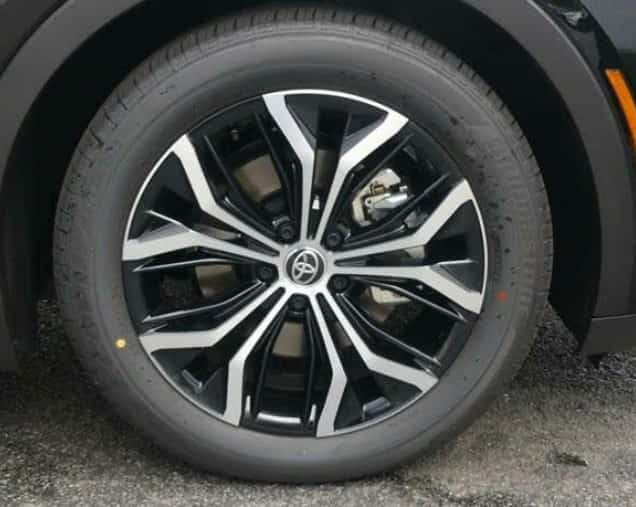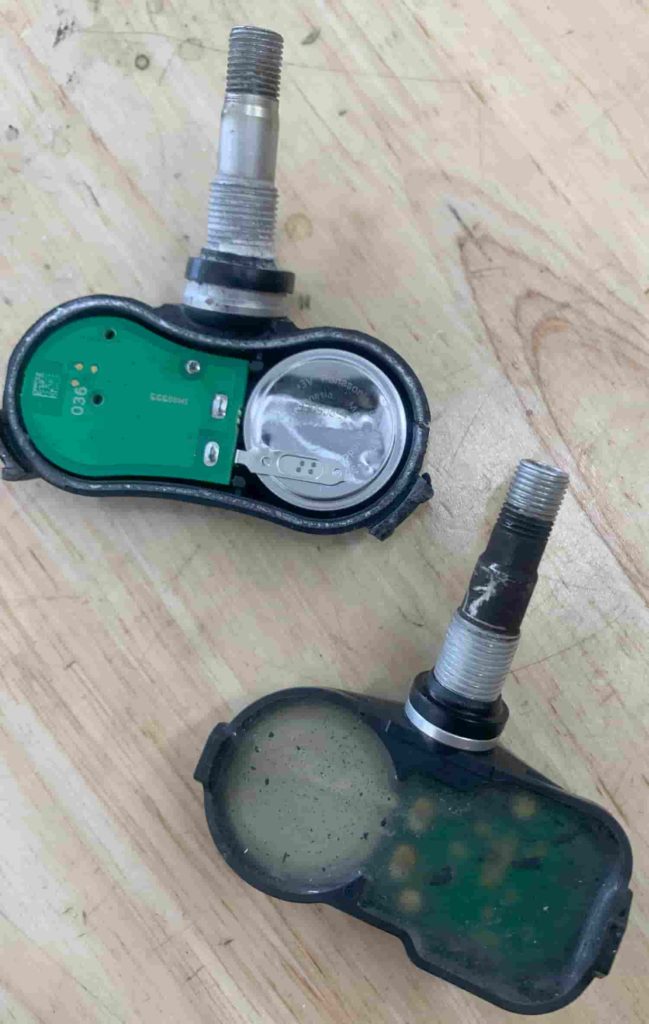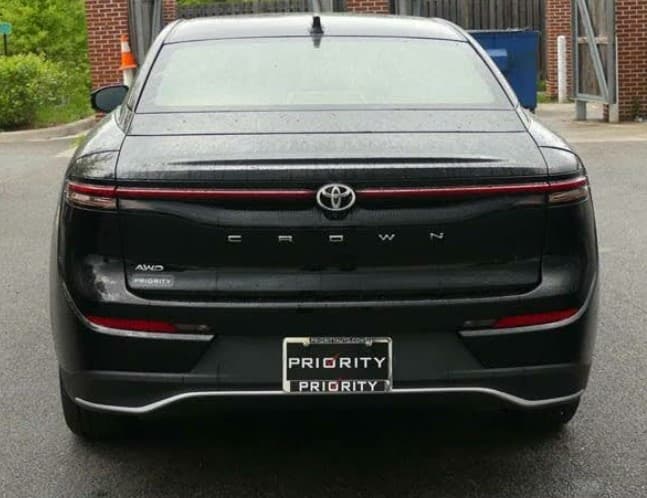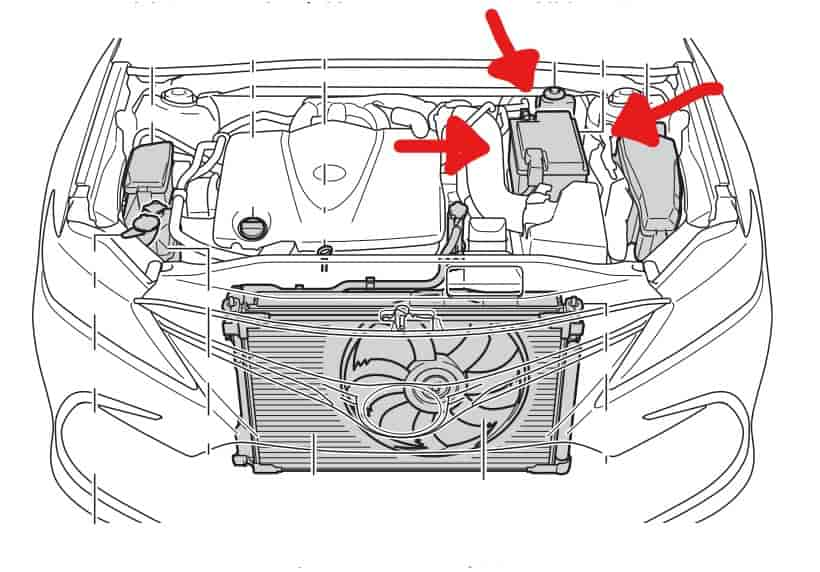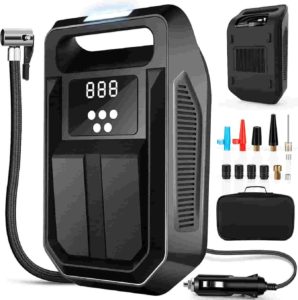What is the Toyota Crown TPMS?
The TPMS, or Tire Pressure Monitoring System, in the Toyota Crown is a system that uses tire pressure sensors to monitor the air pressure in your tires. If the TPMS light on your Crown is illuminated, it means that one or more of your tires is underinflated. The system is designed to help ensure that your tires are properly inflated which can lead to better fuel efficiency, safer driving conditions, and extended tire life. (Toyota sometimes refers to its TPMS as TPWS. It stands for tire pressure warning system and is the same thing as TPMS.)
How Does the Toyota Crown TPMS Work?
The Tire Pressure Monitoring System (TPMS) in a 2023 Toyota Crown is a safety system designed to alert the driver when the tire pressure in one or more of the vehicle’s tires falls below the recommended level. Here’s a detailed explanation of how it works:
Sensors: Each tire, including the spare (if you have a full size spare), has a sensor mounted on the inside of the wheel. These sensors are designed to continuously monitor the air pressure within the tires.
Data Transmission: The sensors transmit the tire pressure data to the vehicle’s onboard computer (this can be referred to as the ECU or TPMS receiver module). This data includes the current tire pressure and the temperature inside the tire. Each sensor has a unique ID number, so the system can differentiate between each tire.
TPMS Light: If the system detects that the pressure in one or more tires is too low (usually 25% below Toyota’s recommended pressure level), it will trigger the TPMS or TPWS warning light on the dashboard. This is a yellow symbol that looks like an exclamation point inside a flat tire or a tire cross-section.
TPMS Reset: If the TPMS light comes on, you should stop as soon as it’s safe to do so and check your tire pressures, then inflate them to the correct pressure. After correcting the tire pressure, you may need to reset the system.
Maintenance: The TPMS sensors are battery-powered and have a lifespan of several years. If a sensor’s battery dies the TPMS light will flash and then illuminate, and the sensor will need to be replaced.
Understanding Tire Pressure
Does Weather Affect Tire Pressure?
In a Toyota Crown, as with any vehicle, the tire pressure is significantly influenced by weather conditions and particularly temperature changes. When the weather gets colder, the air inside the tires contracts leading to a decrease in tire pressure. Conversely, in warmer weather the air expands which can result in increased tire pressure. This is due to the basic principles of physics: for every 10 degrees Fahrenheit change in air temperature, tire pressure will adjust by about 1 PSI (Pound per Square Inch). This is why it’s crucial to check your Crown’s tire pressure regularly and more so during seasonal transitions. A change in weather will cause your tire pressure light to turn on.
How to Check and Adjust Tire Pressure
Here’s a step-by-step guide on how to check and adjust the tire pressure in a Toyota Crown:
Find the Recommended Tire Pressure: Check the owner’s manual or the placard on the driver’s side door jamb to find the recommended tire pressure.
Check the Tire Pressure: Purchase a reliable tire pressure gauge if you don’t already have one. Remove the valve cap from one of your tires. Place the pressure gauge on the valve stem and press down hard enough so that the hiss sound disappears and your gauge provides a reading.
Compare the Pressure: Compare the pressure reading to the recommended pressure you found in the owner’s manual or on the placard.
Adjust the Pressure: If the pressure is too high in any of the tires, release some of the air until it matches the recommended pressure. (gently push the pin inside the valve stem) If the pressure is too low add air in small amounts while checking the pressure after each time until your tire pressure is at the recommended level.
Check All Tires: Repeat this process for all four tires. Don’t forget to check your spare tire as well.
Replace Valve Caps: After adjusting each tire to the correct pressure, don’t forget to securely replace the valve caps. This will prevent dirt and moisture from getting into the valve which could cause a leak.
Regular Checks: Make a habit of checking your tire pressure regularly, at least once a month. Tire pressure should always be checked when the tires are cold, as driving the car warms up the tires and increases the pressure within them, which can lead to a false reading and overinflation.
How Do Underinflated Tires Impact Driving
Driving with underinflated tires can have several negative impacts, including:
Decreased Fuel Efficiency: Underinflated tires have increased rolling resistance, which means your vehicle has to work harder to move leading to higher fuel consumption.
Reduced Tire Lifespan: Underinflation causes tires to wear unevenly and prematurely. The excessive heat generated from underinflated tires can also damage the tire’s internal structure.
Poor Handling: Underinflated tires can negatively affect the vehicle’s handling and stability making it harder to steer especially at high speeds or in sharp turns.
Increased Risk of Tire Damage: Tires that are underinflated are more susceptible to damage such as punctures and blowouts, especially when driving over potholes or debris on the road.
Longer Braking Distance: Underinflated tires can increase your vehicle’s braking distance which could lead to accidents.
Increased CO2 Emissions: As underinflated tires decrease fuel efficiency they indirectly lead to higher CO2 emissions contributing to environmental pollution.
Decreased Comfort: Underinflated tires can lead to a less comfortable ride with more vibration and road noise.
Tire Pressure Light and Safety
What Can Cause the Tire Pressure Light to Turn On?
Spare Tire: If you’re driving with the spare tire installed, it will trigger the tire light to turn on. (If you have a full size spare tire with a sensor in it, the light will not turn on.)
Seasonal temperature changes: A decrease in ambient air temperature can cause tire pressure to decrease, causing the tire light to come on.
Tire puncture or leak: A sharp object or road debris like a nail or screw can puncture a tire, causing air loss which will activate the tire warning light.
Faulty tire pressure sensor: Damaged or malfunctioning sensors may provide inaccurate pressure readings.
Tire damage: Impact from hitting a curb or driving over deep potholes can cause structural damage such as tire bubbles, leading to pressure loss.
Sensor battery life: Tire pressure sensors are battery-powered, and over time, batteries die. This will cause your tire light to turn on and stay on.
Recent tire rotation or replacement: In the event of a recent tire rotation or replacement, the TPMS might need to be reset to prevent incorrect warnings. There are times where the car’s computer could mistakenly identify the front tires as being at the rear, and vice versa after a tire rotation.
Valve stem issues: A damaged or leaking valve stem can lead to air pressure loss and eventual activation of the tire pressure light. There is a rubber gasket in between the sensor base and valve stem that can deteriorate over time causing air to leak out. (it can be replaced)
Wheel or rim issues: Cracked, corroded or damaged wheels can lead to air leaks and pressure loss. This is very common with low profile tires because they offer less protection to the wheel.
Altitude changes: After ascending or descending in altitude tire pressure can change and potentially set off the TPMS alert.
Natural pressure loss: Tires lose air pressure over time due to temperature changes and permeation. Tire dry-rot will happen to tires that sit for long periods of time.
Electrical problems or software issues within the Toyota TPWS. Occasionally the system may have a software update from Toyota.
Is it Safe to Drive With the Tire Light On?
If the tire pressure warning light in your Toyota Crown is on, you need to figure out why to determine if it is safe or not. Is there something like a nail in your tire? Is there a leak? Is the air leaking out of your tire fast or slow? Or is the sensor faulty but the tires are fine? Sometimes it’s okay to drive with the light on, sometimes it’s not. Knowing the exact problem will help you decide if it’s safe to drive and for how long.
Why is the Tire Light On But the Tires Look Fine?
Even if your Toyota Crown’s tires look okay, they might not have the right pressure. It’s important to check the air pressure in all tires including the spare to make sure they’re at the right levels. If the pressures are correct, think about if the weather has changed a lot recently. Does the tire warning light go off when you pump the tires with air but come back on when you start driving? This could mean there’s a leak in the tire. If all the tires keep the right pressure and don’t go flat but the warning light still stays on, the problem might be a malfunctioning tire pressure sensor. This often happens when the sensor’s battery runs out causing a TPMS error.
Understanding Tire Pressure Sensor Batteries
Each tire pressure sensor operates on a built-in battery. It’s important to understand that these batteries aren’t replaceable. They’re attached to the sensor’s circuit board and look like the ones inside wrist watches. When the battery dies, the whole sensor needs to be replaced because it’s fused with the circuit board. The battery life can vary based on driving conditions and weather changes. Generally, these sensor batteries last between 5 to 10 years.
What is the TPMS Malfunction Indicator?
Your Toyota Crown also has a special warning light to alert you to potential issues with your tire pressure monitoring system (TPMS). This warning light is the same yellow exclamation point, identical to the tire warning light. The difference is that if there is an issue with the TPMS, the light will flash for approximately 60 seconds before staying on. This sequence will occur every time you start your Crown until the issue is resolved. When your tire light is blinking or flashing the TPWS may not be able to accurately detect low air pressure. So, a blinking tire pressure light signals a malfunction within the TPMS itself, rather than an actual air pressure concern.
What Can Cause a TPMS Malfunction?
Using non Toyota Crown wheels or tires.
Interference from electronic devices operating on the same radio frequency could potentially hinder the TPWS’s functionality.
If your Toyota Crown has extremely dark window tints, they can interfere with the radio signal transmission between the ECU and tire pressure sensors.
If the tire pressure is extremely high.
If wheels without tire pressure sensors are installed on the car.
If there’s a buildup of ice or snow on or around the tire valves.
If the Toyota Crown TPMS receiver module/ECU does not recognize new tire pressure ID numbers on newly installed sensors.
dfdws
Managing and Troubleshooting TPMS
2023 Toyota Crown Tire Pressure Light Reset Procedure
Park the vehicle in a safe place and stop the engine for 20 minutes or more. Note that the initialization procedure cannot be started while the vehicle is moving.
Adjust the tire inflation pressure to the specified cold tire inflation pressure level. Make sure to adjust the tire pressure to the specified cold tire inflation pressure level. The tire pressure warning system will operate based on this pressure level.
Start the engine.
Select the multi-information display using the meter control switches on the steering wheel.
For a 4.2-inch display: Select “Vehicle Settings” and then press OK. For a 7-inch display: Select the car with the gear icon and then press and hold OK.
Select “TPWS” and then press.
Select “Set Pressure” then press and hold OK until the tire pressure warning light blinks 3 times. A message will be displayed on the multi-information display.
For Toyota Crowns with a tire inflation pressure display function: “– –” will be displayed on the multi-information display for the inflation pressure of each tire while initialization is being performed.
Drive at approximately 25 mph (40 km/h) or more for approximately 10 to 30 minutes.
When initialization is complete, the inflation pressure of each tire will be displayed on the multi-information display.
Even if the vehicle is not driven at approximately 25 mph (40 km/h) or more, initialization can be completed by driving for a long time. However, if initialization does not complete after driving for 1 hour or more, park the vehicle in a safe place for approximately 20 minutes and then drive the vehicle again.
What Tools Do You Need to Reset the Toyota Crown Tire Light?
All you need is a reliable tire pressure gauge. The reset process is integrated into the Toyota Crown’s electronic control unit (ECU).
When Should You Reset Your TPMS?
After Tire Rotations.
If the load weight of the vehicle has changed.
After adjusting tire pressure.
Any time a wheel or tire is removed and then put back on the Crown.
After Replacing a Tire Sensor or Tire valve.
After Tire Balances or Alignments.
How to Install and Calibrate New Tire Pressure Sensors
First, remove the wheel from your Toyota Crown then remove the tire to access the pressure sensor. Remove the old sensor and valve stem. Before installing the new sensor, take a photo of its ID number on the base of the sensor because it will be needed later. Confirm the new sensor is on the same Mhz frequency as the Toyota Crown TPMS receiver module. Use a valve removal tool to insert the new valve through the hole in the wheel. After you’ve put in the new sensor and put the tire back on, you need to sync the sensor with the TPMS. For this, you’ll need a TPMS programming tool. Scan the sensor on each tire then plug the tool into the car’s OBD2 port. The programming tool will program the new sensor to the car’s TPMS.
Troubleshooting Tricks to Reset the Toyota Crown Tire Light
If nothing works when trying to reset your tire pressure light, try these options:
Option 1: Is the Tire Losing Air?
If the light doesn’t immediately turn off after inflating your tires, double-check the pressure in all your tires to ensure they’re at the precise level you set. If only one of the four tires has low pressure, it’s likely that there’s a leak in that tire. Refer to the “identifying a tire leak” section to learn how to detect the source of the leak in your tire.
Option 2: Overinflate
If the tire pressures are exactly as you set them and the tire light still doesn’t turn off, try overinflating your tires to activate the dormant sensor. We suggest inflating the problematic tire to around 45 Psi, which is about 10 Psi above the recommended cold pressure. After overinflating, drive your Toyota Crown for about 10 to 15 minutes. Once the tire light turns off, adjust the pressure back to the recommended level.
Option 3: Reset the Toyota Crown ECU
If your tires aren’t leaking, you can manually clear the error codes from the Toyota Crown’s electronic control unit (ECU). You can do this by disconnecting the negative terminal of the main 12-volt battery. Wait for a short while, then reconnect the terminal. This will erase all the error codes in the ECU, including the error code for the TPMS that causes the tire warning light to come on.
Tire Leaks and Solutions
How to Find a Tire Leak
To find a tire leak in your Toyota Crown first check the air pressure in all the tires to see which one is low. Pump up the tire that’s low on air because it’s hard to find a leak in a flat tire. Next, make a mix of soap and water in a spray bottle (or you can use Windex) and spray it all over the tire. Make sure to also spray the valve stem and bead seal. Get the tire really wet. Wait a little while and then look closely at the tire for any small bubbles. If there’s a leak the air coming out will make tiny bubbles where you sprayed the soapy water. You need to be patient to see these bubbles. If the tire is losing air, there’s definitely a leak so keep spraying and looking for it!
Are Tire Plugs Reliable?
Absolutely! Having used tire plugs countless times while working at tire shops, I can vouch for their effectiveness. They’re excellent for repairing tire holes and punctures, sealing the hole to prevent air leakage. (Just ensure to remove the object that caused the puncture.) Tire plugs are made from durable materials that can withstand fluctuations in air pressure and temperature inside the tire. If installed correctly, a tire plug can last for the tire’s entire lifespan. However, it’s important to note that tire plugs should not be used to repair the tire’s sidewall.
Are Tire Sealants Safe?
Tire sealants should be reserved for emergencies only. They have the potential to ruin your tire pressure sensors and harm the tire itself which can be an expensive fix! This is due to their ability to disrupt the tire’s balance, leading to a vibrating steering wheel while driving. We advise to avoid using tire sealants unless absolutely necessary. If you do end up using one, make sure to take your Toyota Crown to a tire shop ASAP.
TPMS and Legal Considerations
Are TPMS Sensors Legally Required?
In many regions including the United States and Europe, vehicles are legally required to be equipped with tire pressure monitoring system (TPMS) sensors. The TREAD Act, implemented in the U.S. in 2000 stipulates that all vehicles produced after September 2007 must have a TPMS. This law is primarily targeting vehicle manufacturers and aims to enhance road safety by notifying drivers of significant changes in their tire pressure. Similarly, as of November 2012 European regulations mandate that all new passenger vehicles must have a TPMS. These regulations aim to decrease the number of accidents resulting from tire-related problems.
Will My Car Pass Inspection With the Tire Light On?
Yes, your Toyota Crown will still pass state inspection even if the tire pressure light is on. As a certified inspector in New Jersey, I can confirm that a working TPMS isn’t mandatory for passenger vehicles to pass inspection in NJ, even if the tire pressure light is active. Most states will inspect the TPMS but will not fail the vehicle for having the tire pressure light on.
Everything in this article is applicable to all Toyota Crown models and trims including the Toyota Crown XLE, Crown Limited and Crown Platinum.
Please note that this blog post contains Amazon affiliate links. This means that if you make a purchase through one of these links, we at TPMSRESET.com may earn a small commission at no extra cost to you. We only recommend products that we personally use and believe in. Thank you for supporting us.


